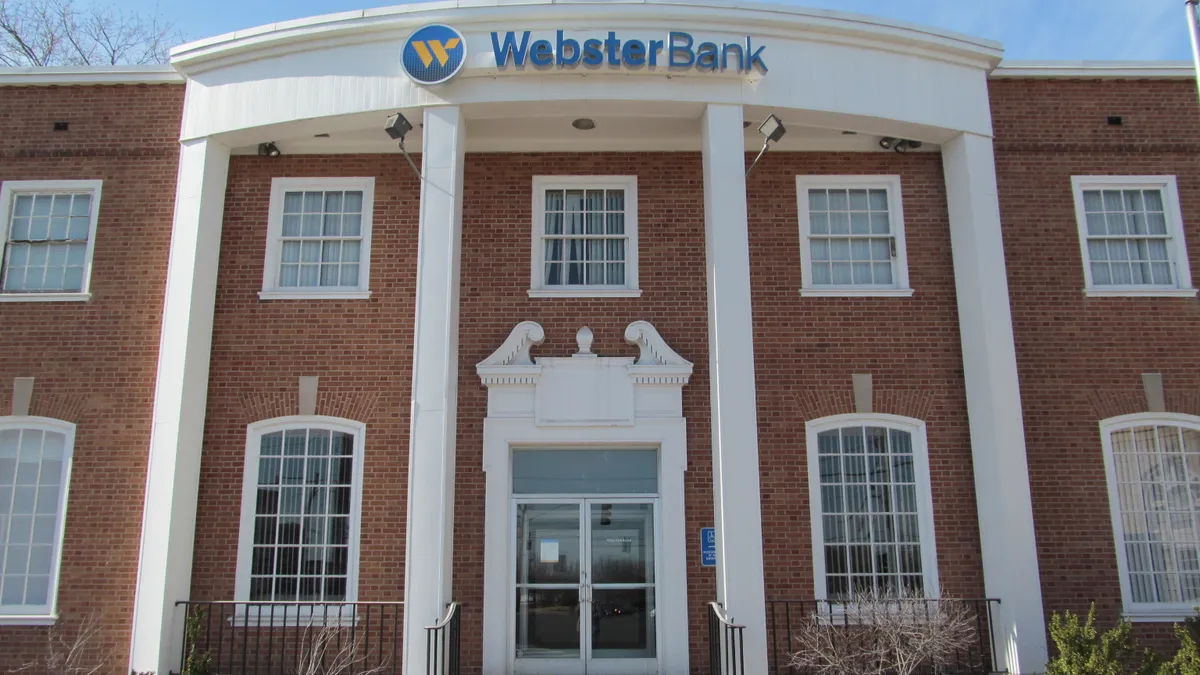When a community's only bank branch leaves town, the lack of financial services can pose a serious drawback for locals.
While residents and small businesses may have digital and mobile banking options to turn to when their brick-and-mortar option disappears, they are left with a lack of credit and cash depositing options that make the void especially hard to fill.
Banks shed 6,764 branches in the U.S., or 7% of the total number, from 2012 to 2017, according to a November report by the Federal Reserve.
The central bank identified 44 "deeply affected" counties that had 10 or fewer branches in 2012 and lost half or more of them by 2017. Thirty-nine of those counties are rural, the Fed found.
These banking deserts, where no banks can be found within 10 miles of populated areas, are becoming increasingly common. Eighty-six new banking deserts were created in rural areas from 2008 to 2016, according to the National Community Reinvestment Coalition (NCRC).
Rural areas can be especially vulnerable to becoming banking deserts because of their already diminished market access.
“These are places that aren't having the vibrant economic growth of the big cities and where the young people get up and move away,” James Angel, professor of finance at Georgetown University’s McDonough School of Business, told Banking Dive. “And when the banks closed down, it makes it hard for the struggling small businesses in the area to do their banking. Whether it's getting change in cash for their customers or getting a small-business loan to finance their inventory, it’s basically making it harder for small-town America to thrive.”
Trading up brick and mortar
Banks are leaving rural America for one simple season, Angel said: money.
“Banks are looking at how much money the branch is generating and saying, ‘Wait a minute, we're not running a charity here. We can’t afford to keep this branch open.’ So they're going to make those hard commercial decisions to close money-losing branches,” he said.
As customers embrace digital banking and transactions become easier via smartphone, some financial institutions are rethinking their brick-and-mortar locations.
PNC, for example, said it plans to close 80 to 100 branches per year over the next five years. But while consolidating branches in areas it no longer considers to be profitable, the Pittsburgh-based bank has also expanded into new markets.
“What we've heard from banks is that there is somewhat of a realignment going on,” Jason Richardson, director of research at the NCRC, told Banking Dive. “They're closing banks in some cities and opening them in others or closing them in parts of one city and moving banks in other places.”
JPMorgan Chase plans to open 400 branches in 20 new markets over the next five years. The bank said 30% of the new branches will be in low- to moderate-income neighborhoods.
Despite the $20 billion expansion plan, the bank’s branch network has been shrinking as it cuts back underperforming locations. JPMorgan had 5,036 branches at the end of 2018, about 2% fewer than in the previous year, CNBC reported.
Banks are also stripping branches back to just their profitable parts, Richardson said.
“Micro branches allow banks to save on the things that really make banks expensive to operate, which are rent and people,” he said. “But I'm not really sure that those fulfill the need that communities have for a bank if it's just basically a glorified ATM lobby.”
A loss of ‘soft information’
When merging banks closed a branch, the number of small-business loans made in the area fell by 13% for more than eight years afterward, a study by an economist at the University of California at Berkeley found.
“There is a very tight relationship between business lending and branch locations,” Richardson said. “Part of that has to do a lot with the way that business lending works, where a lot of it is very relational. Business owners get to know the manager or the business specialist at a local branch.”
That “soft information” — intangible traits such as character, competence and work ethic that’s gathered through relationship banking — gets lost once a bank branch leaves a community.
“One of the big things with small-business credit is the relationship with the banker, where they really understand the person in a way that is much harder to digitize than a generic consumer,” Angel said.
And small businesses can struggle to regain their access to credit once their branch closes, Richardson said.
“It takes them years to rebuild those kinds of relationships with other banks," he said. "Banks fulfill other roles other than the transactions that a bank can measure.”
Credit unions
In some cases, the departing bank works with another financial institution to transition a branch.
When Birmingham, Alabama-based Regions Bank decided it no longer made sense to operate several branches in the Mississippi Delta, it reached out to Hope Credit Union to see if it would be willing to step in.
The credit union took over four bank branches from Regions in 2015. That fit with the credit union’s mission “to improve the quality of life of low-income, low-wealth individuals and communities throughout the Deep South,” said Ed Sivak, Hope Credit Union's executive vice president and chief communications officer.
Regions worked with Hope to ensure there was no loss of service for customers during the process. Regions also helped Hope market itself to new customers in the area.
“It was a win for Regions, it was a win for Hope, and it was a win for the community,” Sivak said.
Hope's member-owned, not-for-profit model allows it to operate in areas that would otherwise become banking deserts, he said.
“As we look at the power of having a financial institution that meets people where they are, the credit union model — and particularly, an institution that is member-owned — really underscores the power of these types of relationships, projects and partnerships,” Sivak said.
Deals between banks and credit unions have become a bone of contention in recent years. Credit unions have announced 16 bank acquisitions in 2019, nearly doubling the nine such deals made in the previous year, according to American Banker. To be clear, Hope did not purchase the Regions branches; the bank donated them.
Critics claim credit unions' tax-exempt status allows them to grow without having to stick to the same regulations as banks. And an aggressive growth strategy goes against credit unions' mission to serve low-income households growth, detractors said.
However, National Credit Union Administration Chairman Rodney Hood said some communities would be without banking access if a credit union hadn't decided to purchase a community bank.
"That would leave them vulnerable to pernicious payday lenders," he told the House Financial Services Committee in December.
“[Credit unions] are more likely to keep those branches open, even if they're not necessarily profitable,” Jordan van Rijn, a senior economist for the Credit Union National Association, told Banking Dive. “They don't have shareholders on top of them saying, ‘Hey, you have to maximize profits.’ Their pressure comes from their members. So they might be much more likely to keep branches open in areas that are not as profitable to provide access to their members, and also open new branches in low-income and diverse areas and perhaps rural areas, as well.”
Digital opportunity
A branch can typically costs between $600,000 and $800,000 a year to run, including overhead and back-office support costs, according to data from Peak Performance Consulting Group.
“Physical infrastructure — particularly branches — constitute a sizable chunk of a bank’s total cost base,” said Daniel Simon, CEO and co-founder of financial services communications agency Vested.
Simon said big banks' de-emphasis on physical branches presents opportunities for digital banks, which aren’t weighed down by the overhead of maintaining brick-and-mortar branches.
“Part of the reason European neobanks like Monzo, N26 and Revolut are eyeing the U.S. market is because they are counting on traditional banks to leave vast swaths of the American consumer underserved,” he said.
Berlin-based N26, which entered the U.S. market in July, announced last month that it has 250,000 consumers in the country. British challenger bank Monzo has launched a U.S. waiting list, and U.S. digital banks such as Chime and Varo are battling for users here.
Varo CEO Colin Walsh, whose bank is working to obtain a national banking charter, said the bank is closely following the growth of banking deserts in the U.S.
“We absolutely care about this and think that it's something where virtual banks and digital banks like ourselves can play a role,” he told the Banking Dive.
Walsh said the bank is using a partnership with mass media corporation iHeartMedia to reach underserved areas that don’t have adequate banking options.
“We have such a local reach now into towns and communities all across the country, and we're working with local DJs, starting to promote the message that digital banking is a very viable alternative,” he said.
However, the NCRC's Richardson said digital banks will never be the only solution to bank deserts.
“They fail to meet several critical functions that an actual physical bank branch fulfills,” he said. “A bank branch is, first of all, a signpost kind of signaling that a neighborhood is financially stable.”
Physical branches offer much-needed cash services for small businesses and serve as commercial tenants for low-to-moderate income areas, functions that digital banks can’t replace, Richardson said.
“Online banks have existed now for quite a while and they're going to have their role to play,” he said. “But the physical footprint is kind of a key component to banking. And if that shrinks, that's going to be problematic."






















